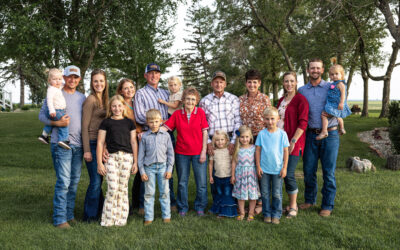
Cows that work, calves that grade
by Miranda Reiman
August 2007
Many beef producers struggle with priorities when it comes to genetic selection. One part of them knows the market rewards a focus on the end product. After all, consumers are the ultimate customers.
Then their skeptical side kicks in: “Yeah, but the most important thing is to get as many live, healthy calves as possible each year, so the cows can earn their keep.”
Those torn by this conflict of the mind can take heart in an updated research paper by Twig Marston, Kansas State University.
Its long title indicates a comprehensive approach. “The Relationship Between Marbling and Other EPDs with Implications When Making Beef Cowherd Breeding and Management Decisions” discusses how carcass quality is related to reproduction.
“For profits to rise, there has to be a balance between product quality, or value, and cowherd production costs,” says Extension beef specialist Marston. “For several decades, there’s been a movement toward value-based marketing, so marbling is an economically important trait.”
Marston says finding that equilibrium should not be difficult.
“Marbling has to be bred into the offspring. It can’t be fabricated from a special environment,” he says. “Luckily, marbling is a moderate to highly-heritable trait. Reproduction, however, is not.”
Although no research examines the direct relationship between marbling and reproduction, studies of other traits point the way.
In one example, Angus sire data were sorted into groups with expected progeny differences (EPDs) that were in the upper or lower percentiles for Marbling Score. “There was no difference in the age of puberty onset between the different sire groups,” Marston says.
The American Angus Association’s newly created Heifer Pregnancy (HP) EPD also supports this. High-accuracy sires show no correlation between HP and intramuscular fat (IMF), marbling, or any growth trait.

“The data says you should be able to select for Heifer Pregnancy without affecting other traits,” he says.
One study suggests marbling and milk EPDs have no effect on age at first calving, but there is a positive relationship between marbling and preweaning gain.
“That is quite favorable if you’re looking to increase both weaning weight and marbling,” Marston says. It follows that increased milking ability eventually increases the ability to marble, he adds.
“Mild correlations exist between lighter birth weights, easier calving and heavier milk production to greater marbling,” he says.
In Angus populations, marbling ability isn’t related to external fat thickness.
“That implies a breeder can match both marbling and do-ability to a particular management system,” Marston says. However, trying to make progress with both traits may yield slower results than choosing one over the other.
The most efficient cows tend to be smaller in weight, stature and milk production, Marston says. “We’d expect marbling to be favored in these smaller cows, because the traits have a slightly negative correlation.”
In the Association’s Dollar Value Index ($V) suite of tools, $ Energy ($E) has a slightly negative (-.12) association with marbling. Marston says that means a cow with a high marbling EPD may be more efficient.
That’s just one more bit of good news for producers who are trying to improve their cowherd and beef-product values simultaneously.
“To maximize returns from tomorrow’s marketing systems, producers will have to meet consumer demands in an efficient manner,” Marston says. “Great genetic strides have been made in the improvement of efficient growth. Now it’s time for producers to maintain the growth advantages and increase carcass quality.”

In adopting their approach to these issues, Marston says producers have sorted themselves into three categories.
“The first group loves their work and lifestyle, but oftentimes goes unrewarded financially because of changes in the market and production environment,” he says. These are the farmers and ranchers “steeped in tradition.”
A second group cuts cost with a focus on record keeping. They make data-driven decisions, but often ignore the ultimate customer. “As long as there’s a commodity market for beef, these producers will have an outlet,” Marston says.
Cattlemen who are committed “food producers” have a greater chance of survival in today’s industry, he says.
“They truly care about the consumers’ wants and find ways to fill their needs. They’re rewarded for their efforts and management,” Marston says. “They anticipate and build the acceptance and demand for beef.”
Marston’s entire white paper is available at https://cabcattle.com/research.
You may also like
North Dakota Partnership Earns CAB Progressive Partner Award
The Bruner and Wendel families earned the 2023 CAB Progressive Partner award by selling high-quality beef through Dakota Angus, LLC, as part of the CAB Ranch To Table program. They focus on their commitment to quality, data-driven decisions, achieve impressive CAB and Prime percentages and offer high-quality beef directly to consumers in their communities.
Saskatchewan Angus Ranch Earns Certified Angus Beef Award
JPM Farms in Canada quietly gained recognition for its dedication to environmental sustainability and quality cattle. The Monvoisin family earned the 2023 CAB Canadian Commitment to Excellence award for their outstanding results and partnership with Duck Unlimited, showcasing their commitment to improving the land, cattle and family daily.
Benoit Angus Ranch honored with CAB Seedstock Commitment to Excellence Award
What started with six Angus heifers, has now grown into 400 Angus females, along with a 2,500 acre farming division. The multi-generation family business focus on improving the reputation on the ranch with high-quality cattle. From the ground up, Benoit Angus Ranch has earned the CAB 2023 Seedstock Commitment to Excellence Award.



